I want to clarify and provide more documentation to support my recent post “Christie DEP Says Your Life is Worth $404,103″
I just read that post again and I realized that fuller explanation in order, because it is so important and because I glossed over some key points. A a result, I may have given some a misleading impression.
So walk with me through this, as I try to boil down the legal and scientific complexity to its essence. I assure you, I saved the best for last, so read on!
The critical issue of concern in the NJ Drinking Water Quality Institute’ February 2009 Report is whether DEP should adopt a drinking water standard (known as an “MCL”, short for”maximum contaminant level” ) for known carcinogen radon 222 and if so, at what level that MCL should be set.
The NJ Safe Drinking Water Act mandates that MCL’s be set for carcinogens at a risk of one in a million (individual excess cancer risk over a lifetime of exposure).
Scientists do risk assessments to derive an MCL based on that risk level. That level of cancer risk is deemed to be “acceptable risk” under NJ law.
The scientifically derived one in a million risk level for exposure to radon 222 is 1.5 picocuries per liter (second paragraph, page 22).
The Subcommittee determined that the drinking water concentration resulting in a one-in one million excess cancer risk over a lifetime exposure for radon in water is 1.5 pCi/L, (second paragraph, page 22).
There are over 1.1 MILLION NJ residents exposed to over 300 picocuries per liter, a level that is two hundred times the acceptable risk level (see Table 4, page 15)
Scientists on the DWQI recommended that DEP adopt an MCL of 800 picocuries per liter (see page 3) – they ignored recommending a drinking water standard for private residential wells, pending additional study.
“NJDEP should initiate rulemaking to establish a MCL of 800 pCi/L of radon in water for community public water supply system” (see page 3)
For over 18 months, DEP has ignored those recommendations and not warned the public about those known risks or invited public comment into their bureaucratic deliberations (which, while shutting out the public did include private water companies) on an MCL that would impact public health.
The cancer risk level for 800 picocuries is 5 in 10,000 (Table 3, page 13)– – that is 500 times higher than NJ’s “acceptable risk” standard of one in a million for carcinogens.
The number of additional deaths between an 800 pico curie versus a 300 standard is 173 (derived from Table 4 page 15).
There is no estimate even provided for the incremental deaths between the risk based 1.5 picocurie MCL versus the recommended 800, but it must be large due to very high exposure rates (over 1.1 million people in NJ are exposed to greater than 300, but not data is provided for the 1.5 risk based number).
The DWQI made the unsafe recommendation of 800 based on a narrow and overly legalistic interpretation of the NJ SDWA – not based on science.
The Act explicitly applies to chemicals that cause cancer (from drinking water exposure pathway), but is silent on radiological emissions from chemicals that cause cancer (via the inhalation pathway).
The DWQI recommendation was based on a differentiation of the mechanism of cancer causation and exposure pathway (in this case radiation). The DWQI is treating cancers caused by chemicals differently than cancers from radiation, which ironically comes from chemicals. While this is biologically accurate, as the mechanisms or carcinogenesis are different, it is absurd law and public policy.
This distinction is an absurd and unwise distinction without a difference that does not protect public health or comply with the spirit of the SDWA.
The DWQI was really concerned about costs of treatment to this health based risk level (i.e. 1.5 picocuries per liter). However, there are legitimate questions as to whether technology can reach this number.
But regardless of the treatment technology issue for 1.5, which can achieve the recommended 800 picocurie per liter standard, the estimated cost at 800 it is $404,103 per life saved (or death avoided) (see Table 6, page 20)
That’s where the DEP’s new “cost benefit analysis” (CBA) policy under Governor Christie’s Executive Order #2 comes in.
You see, that unsafe 800 MCL is too low and costs too much for the poorly trained and amoral economists running the DEP!
So, let’s provide a hypothetical to break down that cost estimate (it is not a true CBA, because no benefits are considered. It is merely a cost of death estimate.)
Let’s assume a small town of 10,000 people. Let’s call it “Martinville”, which is served by the “Christie Water Company” well.
At a cancer risk of 5 in 10,000 (at exposure to 800 picoruies per liter MCL), according to DWQI death cost estimates, Christie Water Company would have to incur treatment costs of $2,020,515.
So, they would have to charge the water customers of Martinville to pay for that system.
Over a 20 year period, payments for that system would cost about $4.04 million. (Sorry, I don’t have a financial calculator, so will take shortcuts and assume a 3.5% interest rate over 20 years, which neatly doubles the initial amount – rule of 70!. Sorry, cant do annual payments and NPV discounted cash flow).
To estimate the impact on individuals of Martinville, lets say $4.04 million/20 years = $202,000/yr
$202,000 year/10,000 residents = $20 per year per person
($20/year/person)/12 months -= $1.68/month/person
($20/year/person)/(365 days/year) = 5.5 cents per day!
So, as we can see, life is cheap and brutal in Martinville under the thumb of the Christie Water Company.
But not in NJ! –
Do you think there is any local government in this state that would oppose increasing water rates 5.5 cents per day to save 5 people’s lives?
Didn’t think so!
So be sure to look for the unsafe levels in water in your town – see Appendix II and III, starting on page 29 (click here) –
The fact that this key information is buried at the end in Appendices only confirms the sage advice of perhaps our best journalist, IF (“Izzy”) Stone, who famously said:
“Always read government documents from back to front – all the good stuff is in the attachments!”
IF Stone is also famous for saying:
All governments lie.
Amen bro!
The Subcommittee determined that the drinking water concentration resulting in a one-inone
million excess cancer risk over a lifetime exposure for radon in water is 1.5 pCi/L,

